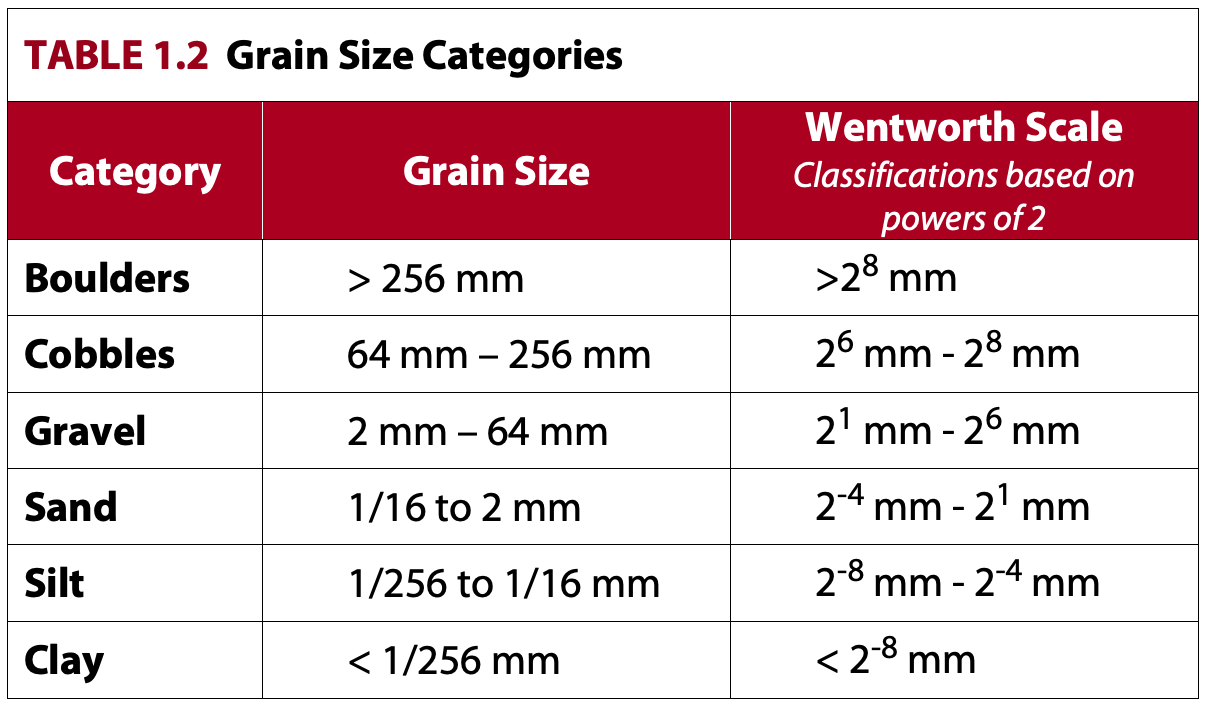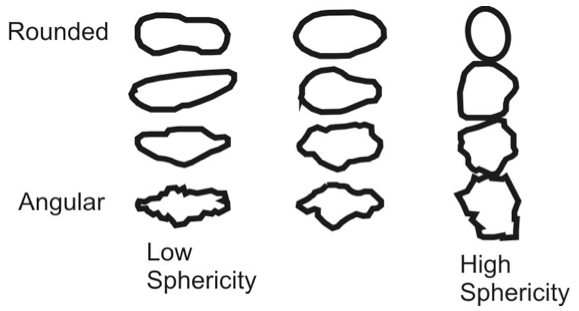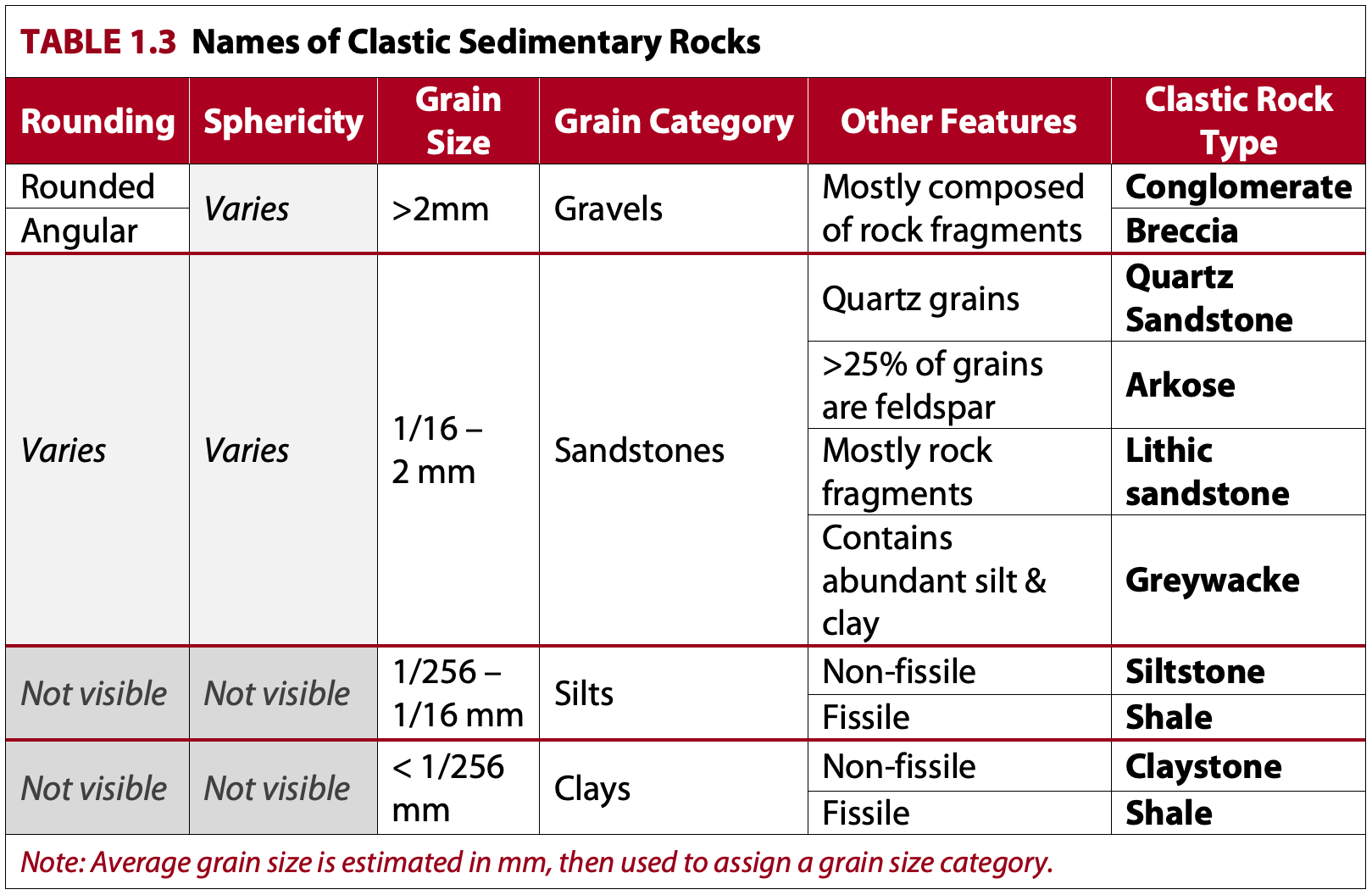Describing and Naming Clastic Sedimentary Rocks
Describing Clastic Sedimentary Rocks
If you took EESC 111 you will have learned to name clastic sedimentary rocks. In this course you will learn to describe clastic sedimentary rocks in order to better understand how and where they were formed.
Geoscientists may be trying to match rocks from one location to another. Rocks seen at two different outcrops may have the same name (for example, sandstone), but this is far from enough information for a geologist to be able to decide if these are in fact the same sandstone. Having a consistent method of writing descriptions is important to be able to compare rocks from one location to another. A full description of a clastic sediment or sedimentary rock must include:
- Colour
- Grain size category
In addition, the following characteristics are included in the description when visible:
- Sorting
- Rounding
- Sphericity
- Any other distinctive features
Note that you won’t be able to determine sorting, rounding, or sphericity from a hand sample if the clasts are too small to see without magnification.
A full description of a clastic sediment or sedimentary rock will take the following form, where parentheses indicate characteristics that may not be possible to determine and include:
Colour, (Sorting), (Rounding), (Sphericity), Grain Size Category, (Other Features)
Each characteristic included in the description is explained in more detail below.
Colour
Colour is an essential descriptor. Rocks are typically described with simple colour descriptions such as “red”, “grey-green”, “tan” or “black and grey”. Colour descriptions may also need to include some information about the arrangement such as “alternating bands of red and grey in 1 to 2 cm bands.” Typically, these colours are just named from common experience as you will be doing in this course. There are instances where colour becomes very important, such as when two fine-grained rocks may be only distinguishable by their exact shade of grey. It then becomes important that all the geoscientists are using the same colour descriptions. A standardized book of colours can then be used to assign precise colours to rocks.
Sediment colour is controlled by many factors but can be used to infer the extent of oxidation during sediment deposition, and hence can provide a clue to the type of location where the sediment was deposited:
- Brown or red typically indicates that the sediment has been exposed to oxygen in the air, usually in a terrestrial environment. Iron in the sediments will oxidize, giving the sediments the brown to red colour.
- Grey and grey-green is common for sediments deposited in shallow and/or circulating water.
- Black typically indicates deep water and/or oxygen depleted water.
You will learn more about this in labs 2 to 4.
Average Grain Size and Grain Size Categories
The average grain size of a clastic rock is measured in mm and is used to assign a description of the grain size by a set of size categories: boulders, cobbles, gravel, sand, silt and clay (Table 1.2). The breakdown of grain size classifications in mm is based upon powers of 2 (e.g., boulders have a diameter of > 28 mm), known as the Wentworth Scale. Geoscientists, engineers, soils scientists and others all use slightly different numbers for historical and practical reasons.

The eye, or in some cases, a hand lens and a grain-size card can be used to help determine the grain size. Sand-sized particles are easy to see with the naked eye and feel “gritty” to the finger tips. Silt-sized particles are at the edge of what is visible to the naked eye and will feel smooth to the fingertip but feel “gritty” when a small fragment is felt between the teeth. Clay-sized particles are small enough that they feel smooth to the fingertip and to the teeth.
The size of grains generally indicates the energy conditions during deposition of the sediments, with larger grains indicating higher energy environments and smaller grains indicating lower energy or calmer environments. High energy water flows typically give way over time to lower energy water flows (e.g.: floods, storms, spring runoff), leading to a variation in grain sizes. High energy water flows sometimes will erode the layers below.
Sorting
Sorting refers to how much variation there is in grain sizes within a rock, and is characterized on a scale ranging from poorly sorted to well-sorted (Figure 1.1). For example, glacial ice can carry all particle sizes; hence, when glaciers deposit sediment it results in a poorly sorted sediment (a wide range of clast sizes). In contrast, wind erodes and transports very specific grain sizes. Therefore, sediment deposited by wind tends to be extremely well-sorted. Clastic rocks may be described as poorly sorted, moderately sorted, or well sorted.

Rounding
Transportation of clasts by wind or water to its final point of deposition rounds the corners off grains by abrasion. Well-rounded grains indicate longer transportation paths. Clastic rocks may be described as poorly, moderately or well-rounded (Figure 1.2). When clasts are microscopic, you cannot describe their rounding.

The degree of rounding can also be influenced by the mineral that makes up the grain. Angular grains of a soft and breakable mineral such as biotite will become rounded much sooner than grains of a hard mineral such as quartz.
Sphericity
This refers to the closeness of a grain shape to a sphere (perfect circle). The sphericity of a clast can be influenced by its mineral composition and the characteristic shape of that mineral. Clastic rocks may be described as having low, medium or high sphericity (Figure 1.3). Note that grains may be well rounded (no sharp edges), yet they may not be spherical. When clasts are microscopic, you cannot describe their sphericity.

Other Features
Several other features of a rock can help distinguish different materials at different locations. These features may or may not be present and therefore are an optional part of a sediment name.
Organic Matter or Fossils
If any organic matter is present it is described by its colour, nature (type), and any distinguishing properties. For example, two sandstones of different origin might be identical in the description based on the particles of sand, but the presence of “black, partially decayed wood fragments” in one, and not in the other can be used to tell them apart. You will learn how to describe fossils in Labs 5-8.
Breakage Patterns
The way that a rock breaks can reveal information about the rock and its history. There are two main ways that a sedimentary rock will break.
Breakage following bedding planes. A bed is a layer of sediment that is distinct from sediments above and below because of differences in grain size, mineralogy, cementing agents, fossils, sedimentary structures, and other properties. The boundary of these bedding planes can sometimes be a weaker plane in the rock, and the rock will tend to break parallel to the bedding.
Fissility. Fine-grained sedimentary rocks that are composed of silt and/or clay sized clasts may also be fissile or non-fissile. Fissile rocks break into thin parallel layers, even when no bedding is visible. This is the result of flat, plate-like clay minerals lining up during deposition from water in a manner that creates planes of weakness. Shale is a fissile clastic sedimentary rock.
Mineral Type
Sands can be composed of fragments of rock (lithic fragments), or they may be composed of grains made up of individual minerals. The type of mineral present in a sandstone can be useful in understanding its history and determining its name. Abundant feldspars and mica may indicate a sand that has not moved far from its origin, as these are physically weaker and more easily weathered minerals. In contrast, a sand composed of nearly pure quartz has likely been transported over a long distance, and the other weaker or more chemically unstable minerals have all weathered. You will learn about some of the most important minerals as we work through Labs 1-4.
Cement
The mineral forming the cement holding a sedimentary rock together can be added. This is typically either silica (quartz) or calcite for clastic rocks. You will not be expected to identify the cementing minerals of clastic sedimentary rocks in this course.
Special Features or Unusual Minerals
The presence of some minerals in a rock can give important clues to its origins, and hence may be noted. For example, the presence of rusty coloured iron oxide minerals is often an important clue that a sediment formed in contact with oxygen on land as opposed to a sediment formed under water. In contrast, the presence of pyrite may indicate that the sediment was deposited in low-oxygen conditions in water. You will learn more about this in Lab 2.
Sedimentary Structures
This is a very important component of a rock description, and will be the focus of the third part of this lab. When you get to the sedimentary structures exercise you will learn about these in more detail.
Naming Clastic Sedimentary Rocks
The names of clastic sedimentary rocks are based on the descriptions you have already learned. Table 1.3 shows how clastic rocks are named.
You must provide a full description followed by the descriptive rock type name, according to the following format:
Colour, (Sorting), (Rounding), (Sphericity), Grain Size, Grain Category, (Other Features): Descriptive Rock Name
For example:
Red, well-sorted, well-rounded, high sphericity, grain size is gravel and larger, grains are rock fragments: Conglomerate

